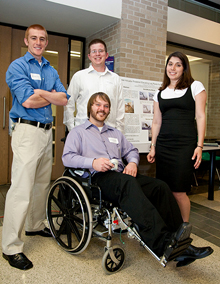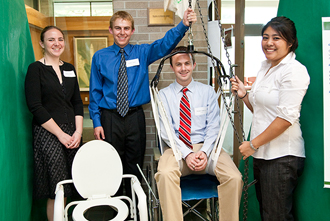Biomedical Engineering Students Think Big for the Disabled
At the 20th annual Biomedical Engineering Design Show on Saturday (March 7), senior Tulane students debuted their designs for devices to assist people with disabilities. Program founder David Rice proclaimed the competition “the best showing ever,” as his students displayed a wheelchair-enhancing device, a playground obstacle course for wheelchairs and walkers and different classroom systems designed to make life easier for students with disabilities as well as their teachers.

Displaying their design of a wheelchair with automated leg rests, which won the show's top prize, are, standing from left, students Christopher Millan, Scott D. Vermeulen and Danielle Gill. Seated is Christopher B. Rodell. (Photos by George Long)
All of the student designers who participated are enrolled in a two-semester course called “Team Design Projects” taught by Rice, who is an associate professor of biomedical engineering in the School of Science and Engineering.
Last fall, the students divided into six teams, chose a client and began the design phase of their projects. Saturday's show was the students' first opportunity to demonstrate their projects to the public. Their clients also were invited.
As the students demonstrated how their projects worked, a panel of judges rated the designs for functionality, aesthetics, safety and durability. The judges included engineering professors, alumni from the design course, healthcare professionals, former clients, and students from the Department of Occupational Therapy at Louisiana State University Health Sciences Center.
Team C.R.A.F.T.E.E., including Danielle Gill, Chris Millan, Chris Rodell and Scott Vermeulen, received the highest score for their automated wheelchair leg rests that enable the user to elevate her legs independently.
Their client, a 93-year-old resident of St. Margaret's Daughters Nursing Home in New Orleans, uses leg rests to relieve discomfort associated with arthritis and edema in her legs, but because of arthritis in her shoulders, she also needs to be able to reach the floor with her feet to propel herself along. Adjusting the leg rests manually is impossible, so Team C.R.A.F.T.E.E. designed leg rests that can be lifted, lowered and rotated with a single control.
“Working on a project that upon completion will help a real person is very rewarding,” said Team C.R.A.F.T.E.E. member Gill. “The entire team has really grown attached to Ms. Rosemary, our client, and is excited about helping her. Our positive relationship has motivated the team throughout the process and ultimately made it easier to finish our design.”
Rice agrees that having real clients to work for enhances the students' experience for several reasons. “The students will buy into a project that they know will go into good hands instead of sitting on the shelf,” he says. “It also prepares them to be able to communicate with clients.”

Students in Team Optimus designed a system to help teachers transfer large students from their wheelchairs to the toilet. They are, from left, Ashlee Riden, Brooks Fowler, Jacques Levet Jr. and Nicolle Christine Perez.
Rice said that this year's teams have been creative and careful in their developing their designs.
“I think they are raising the standards this year,” he said.
Second- and third-highest scores went to Team Optimus and Team Green Wave, respectively, for their projects built for students and staff of Benjamin Banneker School in New Orleans.
Optimus designed a system to help teachers transfer large students from their wheelchairs to the toilet, and Green Wave created a playground learning course that provides a fun way for walker and wheelchair users to learn how to navigate obstacles.
Other projects on display included a leg exercising system for a person with Brittle Bone Disease; a system to help autistic students relate words to pictures and to the sound of the words; and a desk and seating system to enable a student with arthrogryposis, a disease of the joints, to function independently in a classroom environment.
The students will continue product development and testing throughout this spring and, all told, will work about 400 hours on their projects during these two semesters.
